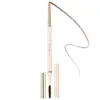What's inside
What's inside
 Key Ingredients
Key Ingredients

 Benefits
Benefits

 Concerns
Concerns

 Ingredients Side-by-side
Ingredients Side-by-side

Hydrogenated Soybean Oil
EmollientSynthetic Wax
AbrasiveSynthetic Fluorphlogopite
Stearic Acid
CleansingHydrogenated Coco-Glycerides
EmollientZinc Stearate
Cosmetic ColorantMyristyl Myristate
EmollientPolyglyceryl-2 Triisostearate
EmulsifyingPolyhydroxystearic Acid
EmulsifyingAluminum Hydroxide
EmollientWater
Skin ConditioningTocopherol
AntioxidantCI 77891
Cosmetic ColorantIron Oxides
CI 77499
Cosmetic ColorantCI 77491
Cosmetic ColorantWater
Skin ConditioningButylene Glycol
HumectantMethyl Trimethicone
Skin ConditioningAcrylates Copolymer
Stearic Acid
CleansingPolyglyceryl-2 Triisostearate
EmulsifyingPalmitic Acid
EmollientCeresin
Emulsion StabilisingSynthetic Beeswax
Emulsion StabilisingSynthetic Wax
AbrasiveHydrogenated Coco-Glycerides
EmollientPolysorbate 60
EmulsifyingCaprylyl Glycol
EmollientGlycerin
Humectant1,2-Hexanediol
Skin ConditioningPhenoxyethanol
PreservativeBentonite
AbsorbentPotassium Sorbate
PreservativeHydroxyethylcellulose
Emulsion StabilisingPvp
Emulsion StabilisingSodium Benzoate
MaskingTromethamine
BufferingAlcohol
AntimicrobialEthylhexylglycerin
Skin ConditioningSodium Dehydroacetate
PreservativeIron Oxides
CI 77891
Cosmetic ColorantC12-15 Alkyl Ethylhexanoate
EmollientPolyethylene
AbrasiveTrimethylsiloxysilicate
EmollientPolyisobutene
Water, Butylene Glycol, Methyl Trimethicone, Acrylates Copolymer, Stearic Acid, Polyglyceryl-2 Triisostearate, Palmitic Acid, Ceresin, Synthetic Beeswax, Synthetic Wax, Hydrogenated Coco-Glycerides, Polysorbate 60, Caprylyl Glycol, Glycerin, 1,2-Hexanediol, Phenoxyethanol, Bentonite, Potassium Sorbate, Hydroxyethylcellulose, Pvp, Sodium Benzoate, Tromethamine, Alcohol, Ethylhexylglycerin, Sodium Dehydroacetate, Iron Oxides, CI 77891, C12-15 Alkyl Ethylhexanoate, Polyethylene, Trimethylsiloxysilicate, Polyisobutene
 Reviews
Reviews

Ingredients Explained
These ingredients are found in both products.
Ingredients higher up in an ingredient list are typically present in a larger amount.
Ci 77891 is a white pigment from Titanium dioxide. It is naturally found in minerals such as rutile and ilmenite.
It's main function is to add a white color to cosmetics. It can also be mixed with other colors to create different shades.
Ci 77891 is commonly found in sunscreens due to its ability to block UV rays.
Learn more about CI 77891Hydrogenated Coco-Glycerides isn't fungal acne safe.
This ingredient is a form of glycerin with emulsifying and emollient properties.
As an emulsifier, this ingredient helps keep products together while adding a thick texture. The manufacturer states this ingredient has emollient properties. Emollients help keep the skin hydrated by trapping moisture in.
Polyglyceryl-2 Triisostearate is created by reacting diglycerin and isostearic acid. Due to the isostearic acid base, it may not be safe for Malassezia or fungal acne.
Learn more about Polyglyceryl-2 TriisostearateStearic Acid is a fatty acid. It is an emollient, emulsifier, and texture enhancer.
As an emollient, stearic acid helps soften skin. It aids the skin's protective barrier by preventing water loss. It also provides a gentle cleansing effect without stripping away natural oils.
Stearic acid may also be used to enhance the texture of products. It can add volume and stabilize ingredients such as water and oil. This can help water and oil ingredients from separating.
Sources of stearic acid include animal or vegetable fats/oils such as coconut or shea. It can be naturally found in butter, cocoa butter, shea butter, vegetable fats, and animal tallow.
This ingredient may not be Malassezia folliculitis, or fungal-acne safe.
Learn more about Stearic AcidSynthetic Wax is created from fossil fuels such as natural gas. It is used to enhance texture, adjust pH, and as an occlusive.
It may also be used as an abrasive ingredient to exfoliate the skin.
Synthetic Wax may not be fungal acne safe.
Learn more about Synthetic WaxWater. It's the most common cosmetic ingredient of all. You'll usually see it at the top of ingredient lists, meaning that it makes up the largest part of the product.
So why is it so popular? Water most often acts as a solvent - this means that it helps dissolve other ingredients into the formulation.
You'll also recognize water as that liquid we all need to stay alive. If you see this, drink a glass of water. Stay hydrated!
Learn more about WaterThis ingredient is a combination of red, black, and yellow iron oxide pigments. This combination of colors is usually found in foundation, because it results in a "skin" color.